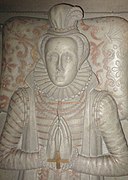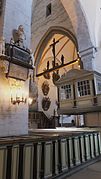St. Mary's Cathedral, Tallinn
- Machine translation, like DeepL or Google Translate, is a useful starting point for translations, but translators must revise errors as necessary and confirm that the translation is accurate, rather than simply copy-pasting machine-translated text into the English Wikipedia.
- Do not translate text that appears unreliable or low-quality. If possible, verify the text with references provided in the foreign-language article.
- You must provide copyright attribution in the edit summary accompanying your translation by providing an interlanguage link to the source of your translation. A model attribution edit summary is
Content in this edit is translated from the existing Estonian Wikipedia article at [[:et:Tallinna toomkirik]]; see its history for attribution. - You may also add the template
{{Translated|et|Tallinna toomkirik}}to the talk page. - For more guidance, see Wikipedia:Translation.
 Estonia
Estonia1330–1430 (enlargement)
1686–1779 (restoration)
Joel Siim
St. Mary's Cathedral, Tallinn (Estonian: Toomkirik, full name: Tallinna Püha Neitsi Maarja Piiskoplik Toomkirik, German: Ritter- und Domkirche, English: The Episcopal Cathedral of the Holy Virgin Mary, Tallinn, also known as the Dome Church) is a cathedral church located on Toompea Hill in Tallinn, Estonia. Originally established by Danes in the 13th century, it is the oldest church in Tallinn and mainland Estonia. It is also the only building in Toompea which survived the 17th-century fire.[1]
Originally a Roman Catholic cathedral, it became Lutheran in 1561 and now belongs to the Estonian Evangelical Lutheran Church. It is the seat of the Archbishop of Tallinn, the spiritual leader of the Estonian Evangelical Lutheran Church, and chairman of that church's governing synod.
The church has been a national cultural monument of Estonia since 20 September 1995.[2]
History
The first church was made of wood most likely already and built by 1219, when the Danes invaded Tallinn. In 1229, when the Dominican friars arrived, they started building a stone church replacing the old wooden one. The monks were killed in a conflict between the Knights of the Sword and vassals supporting the pope's legate in 1233, and the church was thus desecrated. A letter asking permission to consecrate it anew was sent to Rome in 1233, and this is the first record of the church's existence.[3]
The Dominicans could not finish the building and built only the base walls. The building was completed in 1240, and it was a one-aisled building with a rectangular chancel.
In 1240, it was also named cathedral and consecrated in honour of the Virgin Mary. In the beginning of the 14th century, reconstruction of the church began. The church was made bigger. The reconstruction began with building a new chancel. At about the same time, the new vestry was built.
The enlargement of the one-aisled building to a three-aisled building began in the 1330s. The construction work, however, lasted almost 100 years. The new longitudinal part of the church, 29 m (95 ft 2 in) long, built by following the principles of the basilica, was completed in the 1430s. The nave's rectangular pillars had been completed in the second half of the 14th century, though.
The church suffered considerable damage in the great fire of 1684 when the entire wooden furnishings were destroyed. Some vaults collapsed and many stone-carved details were severely damaged – especially in the apse.
In 1686, after the fire, the church was practically rebuilt to restore it to its previous state. The new pulpit with figures of the apostles (1686) and the altarpiece (1696) were made by the Estonian sculptor and carver Christian Ackermann. Paintings were added by Ernst Wilhelm Londicer.
The Dome Church's exterior dates from the 15th century, the spire dates from the 18th century. Most of the church's furnishings go back to the 17th and 18th centuries. From 1778 to 1779, a new baroque spire was built in the western part of the nave.
One should also mention the numerous different kinds of tombstones from the 13th–18th centuries, the stone-carved sarcophagi from the 17th century, also the altar and chancel, chandeliers, numerous coats of arms from the 17th–20th centuries. Two of the church's four bells date back to 17th century, two date to the 18th century. The organ was made in 1914.
Among the people buried in the cathedral are the Bohemian nobleman Jindřich Matyáš Thurn, one of leaders of the Protestant revolt against Emperor Ferdinand II and in events that led to the Thirty Years' War; the Swedish general Pontus De la Gardie and his wife, Sofia Johansdotter Gyllenhielm (King John III's daughter); as well as the Scotsman Samuel Greig (formerly Samuil Karlovich Greig of the Russian Navy); the Swedish field marshals and cousins Otto Wilhelm and Fabian von Fersen; and the Russian navigator, Adam Johann von Krusenstern.
Gallery
-
 Exterior of the apse
Exterior of the apse - Altar in the cathedral
- Interior, facing East
- Tombs inside the cathedral
-
 Detail of Sophia's effigy
Detail of Sophia's effigy - Organ
- Interior
-
 Weather vane
Weather vane
See also

References
- ^ "Toomkirik Tallinn | Estonia - Local Life". www.local-life.com. Archived from the original on 27 December 2023.
- ^ "1087 Tallinna Toomkirik, 13.-19. saj". Kultuurimälestiste register (in Estonian). 2009. Archived from the original on 16 October 2023. Retrieved 10 January 2024.
- ^ "TALLINNA Püha Neitsi Maarja Piiskoplik Toomkogudus". www.eelk.ee (in Estonian). Archived from the original on 25 December 2019.
{{cite web}}: CS1 maint: unfit URL (link)
- v
- t
- e
 Tallinn landmarks
Tallinn landmarksstructures
- Toompea Castle
- Town Hall
- Old Thomas
- Kiek in de Kök
- St Mary's Cathedral
- St. Olaf's church
- St. Nicholas Church
- Church of the Holy Ghost
- Alexander Nevsky Cathedral
- Saint Catherine's Monastery
- Town Hall Pharmacy
- Great Guild
- Pikk Hermann tower
- Knighthood House
- Stenbock House
- Kadriorg Palace
- Presidential Palace
- Pirita Monastery
- Glehn Castle (Tallinn Observatory)
- Maarjamäe Manor
- Maarjamäe Memorial
- TV Tower
- Linnahall
- Patarei Sea Fortress-Prison
- Independence War Victory Column
- Bronze Soldier
- Charles Leroux Monument
- Russalka Memorial
- Raekoja plats
- Freedom Square
- Walls of Tallinn
- House of the Brotherhood of Blackheads
- Tallinn Synagogue
parks
- Tallinn Zoo
- Tallinn Botanic Garden
- Lake Ülemiste
- Lake Harku
- Pirita River
- Aegna island
- Kadriorg Park
- Danish King's Garden
- Kanuti Garden
- Kuberneri Garden
- Komandandi Garden
- Toompark
- Hirvepark
- Harjumägi
- Lindamägi
- Tammsaare Park
- Police Garden
- Löwenruh Park
- Glehn Park
- Jüriöö Park
- Pae Park
- Lillepi Park
- Kakumäe Coastal Park
- Kopli cemetery
- Kalamaja cemetery
- Metsakalmistu
| Museums and galleries |
|
|---|---|
| Theatres | |
| Other |
education



















